

Architecture is a timeless testament to human ingenuity, reflecting the evolution of societies and cultures throughout history. From ancient wonders to modern marvels, the built environment tells a compelling story of innovation, aesthetics, and functionality. To truly appreciate the architectural wonders that surround us, it is essential to delve into the rich tapestry of architectural history. In this exploration, we uncover six fascinating facts that shed light on the evolution of architecture, offering insights into the minds and hands that shaped our world.
Ancient Foundations
At the dawn of civilization, architecture emerged as an indispensable aspect of human progress. The birth of architecture can be traced back to the ancient civilizations of Mesopotamia, Egypt, and the Indus Valley. These cultures created monumental structures like the ziggurats, pyramids, and the Great Bath, showcasing advanced engineering and an understanding of aesthetics. Architecture in ancient times was closely tied to religious and cultural beliefs, with structures serving as both practical solutions and symbolic expressions of societal values. The longevity of these ancient wonders attests to the enduring legacy of architectural principles established thousands of years ago.
The Renaissance Revolution
The Renaissance marked a pivotal period in architectural history, as it witnessed the revival of classical ideas and a renewed interest in the achievements of ancient Rome and Greece. Architects such as Leon Battista Alberti and Filippo Brunelleschi looked to classical proportions and mathematical principles to create harmonious and visually pleasing structures. The use of columns, arches, and domes became widespread, contributing to the emergence of a distinctive Renaissance architectural style. This period not only celebrated the technical prowess of architects but also emphasized the integration of art and architecture, giving rise to buildings that were not merely functional but also aesthetically sublime.
The Modern Movement
The 20th century brought about a seismic shift in architectural philosophy with the advent of the Modern Movement. Led by pioneers like Le Corbusier and Frank Lloyd Wright, this era embraced the mantra “form follows function.” Rejecting the ornate styles of the past, modern architects sought simplicity, functionality, and the use of innovative materials. The Bauhaus school, founded by Walter Gropius, played a pivotal role in promoting the fusion of art, craft, and technology in architectural design. Skyscrapers, characterized by steel and glass constructions, became icons of the modern cityscape. The Modern Movement not only transformed the physical appearance of buildings but also influenced urban planning, fostering a new way of thinking about the relationship between architecture and the evolving needs of society.
Cultivating Aesthetic Landscapes
In parallel to the evolution of architectural styles, the art of landscaping and gardening has played a significant role in enhancing the beauty of architectural spaces. Today, there are companies dedicated to providing high-quality gardening products that cater to the discerning tastes of homeowners and landscape architects alike. These companies offer an array of meticulously crafted items, from elegant garden furniture to exquisite planters and trellises. One such noteworthy product that seamlessly blends with historical architectural aesthetics is the garden obelisk.
These tall, tapered structures not only serve as visually striking garden features but also hold a historical significance. By partnering with reputable suppliers, enthusiasts can uncover the secrets behind the obelisk’s history and integrate these timeless elements into their landscapes, creating a harmonious blend of history and horticulture. In cultivating aesthetic landscapes, the integration of high-quality gardening products not only adds visual appeal to architectural spaces but also provides an opportunity for individuals to connect with the past. By carefully selecting and incorporating items like garden obelisks, enthusiasts can infuse their outdoor spaces with a sense of history, creating a living tapestry that harmonizes architectural sophistication with the timeless beauty of nature.

Sustainable Architecture
As architectural trends continue to evolve, there is a growing emphasis on sustainability and eco-conscious design. Sustainable architecture seeks to minimize the environmental impact of buildings by incorporating energy-efficient materials, renewable resources, and innovative technologies. From green roofs that reduce heat absorption to passive solar design principles, the integration of sustainable features is reshaping the way architects approach their craft. This shift towards environmentally conscious practices not only benefits the planet but also promotes a harmonious coexistence between the built environment and nature. Understanding the principles of sustainable architecture is crucial for architects, builders, and homeowners alike as we collectively strive to create a more ecologically responsible future.
Architectural Diversity Across Cultures
Architecture is a universal language that transcends borders, yet it manifests in diverse forms across different cultures. Exploring architectural diversity unveils a rich tapestry of styles, materials, and techniques shaped by cultural values and historical contexts. From the intricate wooden structures of traditional Japanese architecture to the vibrant colors and patterns of Moorish design, each culture contributes unique elements to the global architectural mosaic. Understanding this diversity fosters cultural appreciation and inspires architects to draw inspiration from a wide array of influences, creating a more inclusive and interconnected architectural landscape that reflects the richness of human heritage.
In the exploration of architectural history, we’ve journeyed from the ancient foundations of monumental structures to the Renaissance revival of classical ideals, the modern movement’s functional innovation, and the integration of high-quality gardening products that connect us to our historical roots. The evolution continues with a focus on sustainability, nurturing the environment through eco-conscious design, and an appreciation for the diverse architectural languages spoken across cultures. As we navigate the ever-changing landscape of architecture, it is the amalgamation of these elements that allows us to create spaces that not only stand as testaments to our past but also pave the way for a more sustainable and culturally enriched future.


